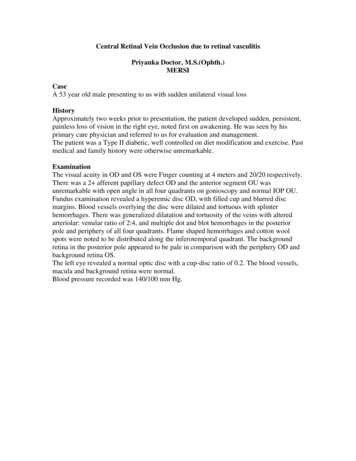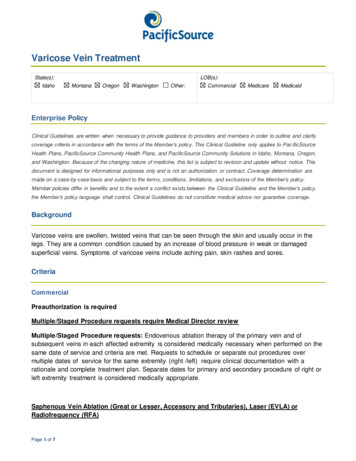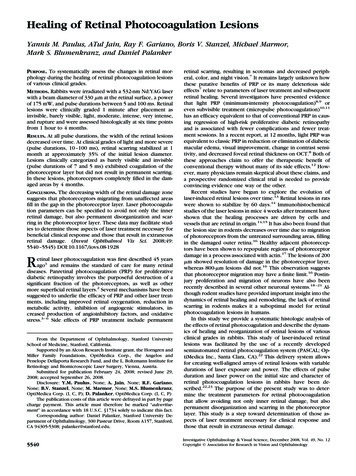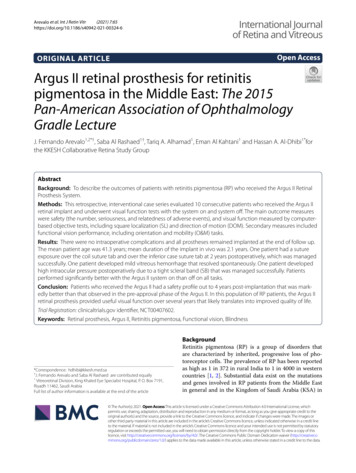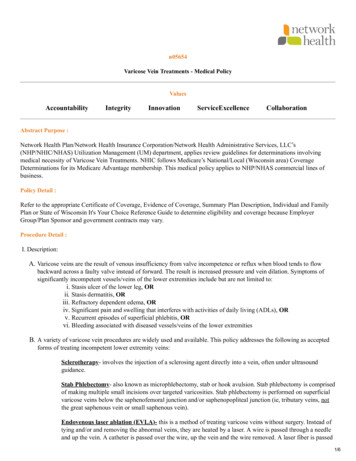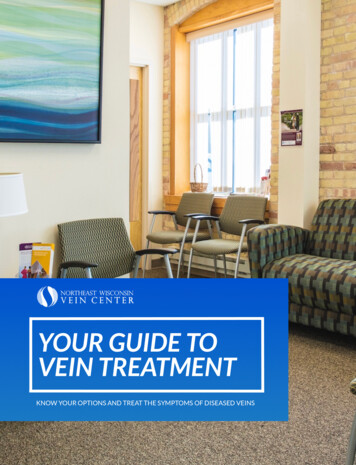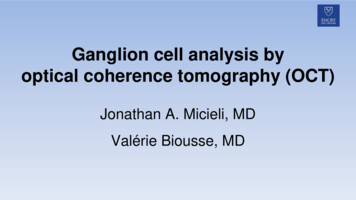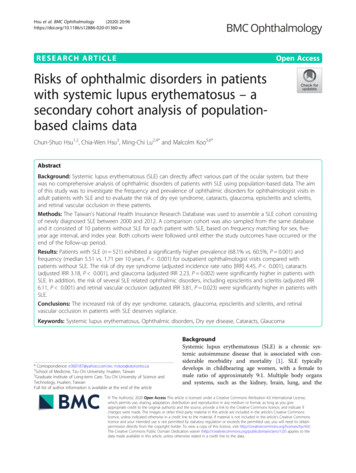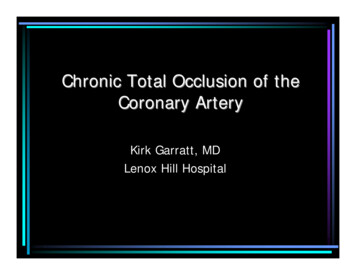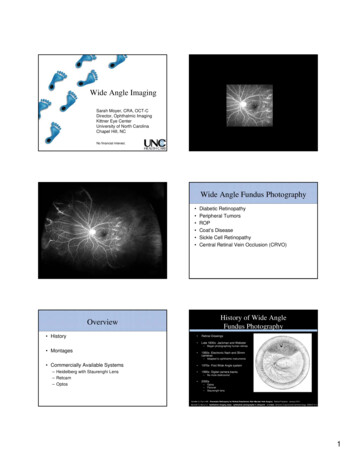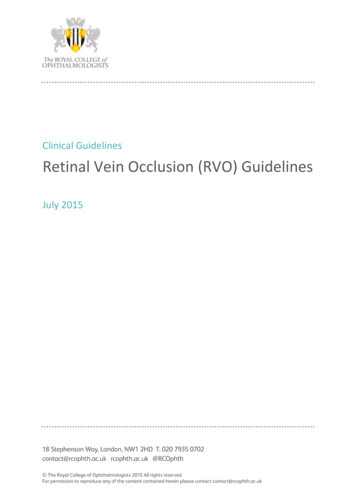
Transcription
Clinical GuidelinesRetinal Vein Occlusion (RVO) GuidelinesJuly 2015
ContentsSectionSummaryRVO Guidelines Expert Working Party MembersDeclarations of InterestConsultation processSearch StrategyReview Date: September 2017PrefaceEVIDENCERECOMMENDATIONSSection 1: Terminology and Disease DefinitionRetinal vein occlusion (RVO)Central retinal vein occlusion (CRVO)Branch retinal vein occlusion (BRVO)Hemi-retinal vein occlusion (HRVO)Macular Oedema (MO):Retinal ischaemia and iris and retinal neovascularisation:Ischaemic versus non-ischaemic RVO:Section 2: Natural History of Retinal Vein OcclusionsCentral Retinal Vein OcclusionBranch Retinal Vein OcclusionBilateral involvementpage444555556666666777788Section 3: Epidemiology of Retinal Vein Occlusion8Section 4: Aetiology and risk factors of Retinal Vein Occlusions9Associations with retinal vein occlusions9Section 5: The relation of RVO to systematic vein occlusions and the role oftesting for venous occlusions risk factors11Section 6: Cardiovascular morbidity and mortality12Is RVO a predictor for the future development of stroke?Is RVO associated with increased mortality?Section 7: Distinct clinical entities of retinal vein occlusionHemisphere vein occlusionRVO in younger patients (less than 50 years of age)Section 8: Medical investigations in retinal vein occlusionsSummary of recommended medical investigations in the eye clinic:Section 9: Ophthalmological management of CRVOMacular oedemaAnti-VEGF TherapiesTranslation of current clinical trials on anti-VEGF therapy in CRVO into clinical practiceIschaemic central retinal vein occlusionManagement of ischaemic central retinal vein occlusion and anterior segmentneovascularisationManagement of posterior segment neovascularisationPan-retinal Photocoagulation TechniqueManagement of established neovascular glaucomaRecommendations for Further Follow-upExperimental treatmentsSection 10: Ophthalmological management of 23232
Treatment of macular oedemaTable 1: Visual outcomes of macular oedema due to branch retinal vein occlusion inrandomised clinical trials.Translation of clinical trials in BRVO into clinical practice:Treatment of neovascularisationExperimental Treatments2427272829Section 11: Treatment Algorithm29Treatment algorithm for CRVOTreatment algorithm for BRVOII ISCHAEMIC BRVO293132Section 12: RVO Service Provision32Burden of disease due to RVOExisting service provision and referral pathwaysAnticipated workloadRVO Service Specifications32323233Section 13: Research34Section 14: Cited References352015/SCI/3523
SummaryRVO Guidelines Expert Working Party MembersChair:Mr Philip Hykin, Moorfields Eye Hospital, LondonMembers:Miss Sobha Sivaprasad, Moorfields Eye Hospital and Kings College Hospital, LondonMr Winfried Amoaku, Nottingham University Hospital, NottinghamMr Tom Williamson, Guy’s and St Thomas Hospital, LondonProf Paul Dodson, Birmingham Heartlands Hospital, BirminghamMr James Talks, Royal Victoria Infirmary, Newcastle upon TyneDr Katherine Talks, Royal Victoria Infirmary, Newcastle upon TyneMiss Khanchan Bhan, Moorfields Eye Hospital, LondonDeclarations of InterestThe Chair has received research and educational grants from Novartis, Bayer, Allergan, andhas worked on consultancy for Bayer, Allergan and Novartis.Miss Sobha Sivaprasad has received an honorarium for advisory board meetings and speakerfees from Allergan, Novartis, Bayer and Roche. Been awarded institutional research grantsby Novartis, Bayer, Allergan. Received support from industry towards publication for theAURA study and RELIGHT, and research grants from Research Grants: Novartis, Bayer,Allergan.Mr Winfried Amoaku has received research funding from Allergan, Bausch and Lomb,Novartis and Pfizer, is on an Advisory Board for Alcon, Allergan, Novartis, Bayer, Alimera,Roche and Thrombogenics, has received educational travel grants from Bayer, Novartis andPfizer, speaker honoraria from Alimera, Allergan, Bausch and Lomb, Bayer, Novartis andPfizer. He is has been involved with Pharma-sponsored Clinical Trials: Allergan, Bausch andLomb, Novartis, Pfizer2009 – 14. Clinical Trials: i) National CI (and PI, Nottingham) Pfizer.Case-Crossover Study of PDE5 Inhibitor as factor in AION; ii) PI- Novartis. REPAIR Phase 2,Protocol CRFB002AGB10. Multicentre; iii) PI- Novartis. COMRADE B and C. Phase 3, ProtocolCRFB002 EDE17 and CRFB002 EDE18. Multicentre trial ranibizumab vrs dexamethasone inBRVO and CRVO; iv) PI- Phase 4 Observational Constance. He is also a member of theMacular Society Scientific Committee.Mr Tom Williamson has worked with research groups for Axsys Systems, and receivedfunding for reports and publication work from Bayer. He is a member of an advisorycommittee for Bausch and Lomb and is a Director/Employee of the Consultant Eye SurgeonsPartnership London and the London Claremont Clinic.Mr James Talks has attended Advisory Boards for Bayer, Novartis and Allergan. He hasparticipated in Pharma-sponsored Clinical Trials for Bayer and Novartis. He has also receivededucational travel grants from Bayer.Dr Katherine Talks has been a member of an Advisory Board for Bayer which was not relatedto any aspect of these guidelines.2015/SCI/3524
Consultation processThe guideline development group invited comments on this guideline from all UK consultantophthalmologists and The Royal College of Ophthalmologists Lay Advisory Group prior topublication.Search StrategyMedline was used by individual authors of each section with relevant search terms scanningthe database for duration up to 30th June 2014. The previous edition of the RCOphthguidelines and NICE single technology appraisals were used as reference sources. The formatof the guidelines was changed to reflect the RCOphth Diabetic Retinopathy Guideline.Review Date: September 2017PrefaceSince the publication of the previous edition of the Royal College of OphthalmologistsRetinal Vein Occlusion Guidelines (2010), a number of clinical studies have expanded theunderstanding of the condition and its management. Similarly, technological advances inretinal imaging including high definition Optical Coherence Tomography (OCT) and wide fieldretinal angiography have helped broaden clinical knowledge and facilitate treatmentdecisions. Novel therapies, rapidly becoming standard treatments, have revolutionised themanagement of RVO patients in clinical practice. The new guidelines aim to reflect all thesechanges and provide up to date guidance for busy clinicians. They will be updated on-line asnecessary so as to keep abreast of significant further developments in the field.The aim of the guidelines is to provide evidence-based, clinical guidance for the appropriatemanagement of different aspects of RVO. The foundations of the guidelines are based onevidence taken from the literature and published trials of therapies as well as consensusopinion of a representative expert panel convened by the Royal College of Ophthalmologistswith an interest in this condition. The scope of the guidelines is limited to current diagnostictools, management and service set-up and delivery to facilitate delivery of optimal clinicalcare pathways and management for patients with RVO. The guidelines are preparedprimarily for ophthalmologists; however they are relevant to other healthcare professionals,service providers and commissioning organisations as well as patient groups. The guidelinesdo not cover the rare, complex, complicated or unusual cases. It is recommended thatreaders refer to other relevant sources of information such as summaries of productcharacteristics (SPCs) for pharmaceutical products as well as the National Institute of Healthand Care Excellence (NICE) and General Medical Council (GMC) guidance.The new guidelines incorporate established and applicable information and guidance fromthe previous version with revision. Other chapters have been extensively revised and somenew chapters are added. As stated in the previous version, the guidelines are advisory andare not intended as a set of rigid rules, since individual patients require tailored treatmentfor their particular circumstances. However, it is hoped that, if used appropriately, theguidelines will lead to a uniformly high standard of management of patients with RVO.EVIDENCE is graded on three levels:Level 1: Evidence based on results of randomised controlled trials (RCTs) power calculationsor other recognised means to determine statistical validity of the conclusion.2015/SCI/3525
Level 2: Evidence based on results of case studies, case series or other non-randomisedprospective or retrospective analysis of patient data.Level 3: Evidence based on expert opinion, consensus opinion or current recognisedstandard of care criteria where no formal case series analysis was available.RECOMMENDATIONS for practice are based on treatment protocols and measures, whichwere recognised to improve patient care and/or quality of life based on:Level A: where strength of evidence was universally agreedLevel B: where the probability of benefit to the patient outweighed the risksLevel C: where it was recognised that there was difference of opinion as to the likely benefitto the patient and decision to treat would be made after discussion with the patientSection 1: Terminology and Disease DefinitionRetinal vein occlusion (RVO) is an obstruction of the retinal venous system by thrombusformation and may involve the central, hemi-central or branch retinal vein. The mostcommon aetiological factor is compression by adjacent atherosclerotic retinal arteries. Otherpossible causes are external compression or disease of the vein wall e.g. vasculitis.Central retinal vein occlusion (CRVO) results from thrombosis of the central retinal veinwhen it passes through the lamina cribrosa.1,2 It is classically characterised by disc oedema,increased dilatation and tortuosity of all retinal veins, widespread deep and superficialhaemorrhages, cotton wool spots, retinal oedema and capillary non-perfusion in all fourquadrants of the retina. In less severe forms the disc oedema may be absent. A previousCRVO may show evidence of optic disc and retinal collaterals, a telangiectatic capillary bedand persistent venous dilation and tortuosity, perivenous sheathing, arteriolar narrowing,and macular abnormalities (chronic macular oedema and retinal pigment epithelialchanges).Branch retinal vein occlusion (BRVO) is caused by venous thrombosis at an arteriovenouscrossing where an artery and vein share a common vascular sheath.3,4 It has similar featuresto CRVO except that they are confined to that portion of the fundus drained by the affectedvein.Hemi-retinal vein occlusion (HRVO) affects either the superior or inferior retinalhemisphere, and the retinal haemorrhages are nearly equal in two altitudinal quadrants (thenasal and temporal aspects) of the involved hemisphere.The two main complications of RVO are macular oedema and retinal ischaemia leading to irisand retinal neovascularisation.Macular Oedema (MO): Thrombosis of the retinal veins causes an increase in retinalcapillary pressure resulting in increased capillary permeability and leakage of fluid and bloodinto the retina. Co-existent retinal ischaemia (see below) may exacerbate this process by theproduction of vascular endothelial growth factor (VEGF) which in turn promotes retinalcapillary permeability and leakage into the extracellular space resulting in furtherdevelopment of MO. MO is the most common cause of visual impairment in RVO, followedby foveal ischaemia.2015/SCI/3526
Retinal ischaemia and iris and retinal neovascularisation: Varying degrees of retinalischaemia due to non-perfusion of retinal capillaries may occur and principally depends onthe degree of retinal vein thrombosis. These changes result in increased production of VEGFand other cytokines, which promote new vessel formation principally but not exclusivelyinvolving the iris and angle in CRVO and the retina in BRVO. These complications can lead toneovascular glaucoma, vitreous haemorrhage and tractional retinal detachment with severevisual impairment.Ischaemic versus non-ischaemic RVO: Both CRVO and BRVO can be broadly classifiedinto ischaemic and non-ischaemic types based on the area of capillary non-perfusion, andthis distinction is useful for clinical management. The Central Retinal Vein Occlusion study(CVOS) defined ischaemic CRVO as fluorescein angiographic evidence of more than 10 discareas of capillary non-perfusion on seven-field fundus fluorescein angiography.5,6 However,this definition may require revision to be appropriate for the more recently adopted wideangle imaging. It is important that a clear distinction is made between foveal ischaemia andan ischaemic RVO (i.e. global retinal ischaemia).Ischaemic CRVO is associated with one or more of the following characteristics:1. Poor visual acuity (44% of eyes with vision of 6/60 develop rubeosis[CVOS])5,62. Relative afferent pupillary defect3. Presence of multiple dark deep intra-retinal haemorrhages4. Presence of multiple cotton wool spots5. Degree of retinal vein dilatation and tortuosity6. Fluorescein angiography showing greater than 10 disc areas of retinalcapillary non-perfusion on 7-field fluorescein angiography (CVOS)5,67. Electrodiagnostic tests (ERG): reduced b wave amplitude, reduced b:a ratioand prolonged b-wave implicit time on the electroretinogram7,8,9,10,11There is no evidence as to which combination of the above characteristics best definesischaemic CRVO. It is important to note that up to 30% of eyes with initially non-ischaemicCRVO may convert to ischaemic subtype.11,12,13,14 This is usually heralded by further rapidvisual deterioration and requires additional assessment.The prevalence and incidence of ischaemic BRVO is not fully defined. Ischaemia involving themacula causes visual impairment. However, ischaemia may occur in peripheral areas of theretina and result in retinal neovascularisation and vitreous haemorrhage. Neovascularglaucoma is rare in ischaemic BRVO.Section 2: Natural History of Retinal Vein OcclusionsCentral Retinal Vein OcclusionAlthough some patients with CRVO can experience an improvement in MO and visual acuity,visual acuity generally decreases over time. A systematic review on the natural history ofuntreated CRVO reported that only a small proportion of patients showed spontaneousimprovement in visual acuity and their final visual outcome at 3 – 40 months was nottypically greater than 73 ETDRS letters (Snellen equivalent 6/12). Only 20% of patients who2015/SCI/3527
present with an initial visual acuity of 35 – 65 ETDRS letters (Snellen equivalent 6/60 to 6/18)are likely to improve spontaneously.Non-ischaemic CRVO may resolve completely without any complications. Follow-up of suchcases for at least two years is usually recommended but the development of disc collateralsand the resolution of macular oedema for at least 6 months should allow the discharge ofthe patient from clinical supervision. However, 30% may convert to an ischaemic CRVO overthree years due to an increase in area of non-perfusion. More than 90% of patients withischaemic CRVO have a final visual acuity of 6/60 or worse.5,6Branch Retinal Vein OcclusionBased on the Branch Retinal Vein Occlusion study (BVOS),15 the prognosis of BRVO is betterthan CRVO with approximately 50 – 60% of untreated BRVO cases retaining a visual acuity 6/12 after one year.Therefore when a patient presents with recent onset mild visual impairment due to MOsecondary to BRVO, it may be reasonable to observe the progress of the condition over thefirst three months of follow up. However presentation may be delayed in some patients andin others with significant visual impairment at presentation, only 18 to 41% of eyes improvespontaneously with visual acuity not improving to 6/12 on average, suggesting earlytreatment may be appropriate in these cases.However, many patients may not present immediately and only 18 – 41% of eyes with MOdue to BRVO at presentation show spontaneous improvement and, on average, visual acuitydoes not improve above 6/12 in this cohort. Approximately 20% of untreated MO due toBRVO experience significant deterioration of visual acuity over time.15Bilateral involvementThe majority of RVO cases present as a unilateral condition. However, 5 – 6% present withevidence of bilateral BRVO and10% of the BRVO patients will have fellow eye involvementover time. Similarly, approximately 10% of CRVO patients present with bilateral involvementat baseline and 5% may have fellow eye involvement over a one year period.16Section 3: Epidemiology of Retinal Vein OcclusionRetinal vein occlusions are a common cause of visual loss in the United Kingdom, and are thesecond commonest cause of reduced vision due to retinal vascular disease after diabeticretinopathy, with BRVO occurring 2 – 6 times as frequently as CRVO.15 There is noprevalence or incidence data from England or Wales. US data reported in 2008 indicate a 15year incidence of 500 new cases of CRVO per 100,000 population and 1800 BRVO cases per100,000 population.17The incidence and prevalence of both these conditions increases with age. Australian datasuggests that the prevalence of RVO is 0.7% for those younger than 60 years, 1.2% for those60 – 69 years, 2.1% for those 70 – 79 years and it increases to 4.6% in people aged 80 yearsor above. No gender or racial differences in prevalence of both these conditions have beenreported.Most patients are unilaterally affected by this condition. Under 10% of CRVO are bilateral atpresentation (range 0.4% to 43%). The fellow eye involvement over a one year period is2015/SCI/3528
approximately 5%. Similarly, only 5% – 6% of patients at baseline have BRVO in both eyes atdiagnosis with 10% showing bilateral involvement over time.Visual impairment is more frequent with CRVO than BRVO. Macular oedema (MO) is theleading cause of visual impairment. It is estimated that approximately 11,600 people withBRVO and 5,700 people with CRVO suffer from visual impairment due to MO each year inEngland and Wales based on an annual incidence of BRVO of 0.12% and CRVO of 0.03% inpeople aged 45 years or older and 85% of BRVO and 75% of CRVO developing MO within twomonths of diagnosis and 50% of BRVO and 100% of CRVO experiencing visual impairmentdue to MO (NICE 2011).Section 4: Aetiology and risk factors of Retinal Vein OcclusionsRetinal vein occlusion is due to thrombosis of retinal veins (central, hemi or branch).1,2,18Atherosclerosis of the adjacent central retinal artery possibly compresses the central retinalvein at the lamina cribrosa leading to consequent thrombosis in the venous lumen. Rarely,retrobulbar external compression from thyroid eye disease, orbital tumour, or retrobulbarhaemorrhage may be a cause. Whether primary thrombosis plays a role in this conditionremains questionable. The clinical appearance is largely related to retinal ischaemia and theeffects of elevated concentrations of VEGF in the vitreous and retina. Animals injected withVEGF will develop retinal hemorrhages and the use of anti-VEGF causes retinal hemorrhagesto resolve. Branch retinal vein occlusions may relate to the point of arterial venous crossingin the retina.Associations with retinal vein occlusionsThe following conditions have variably been reported as associations: 1,23,24Hyperlipidaemia25HyperhomocysteinaemiaBlood coagulation disorders: high plasma viscosity such as due to leukaemia,myeloma, Waldenstrom’s macroglobulinaemia, myelofibrosis, changes in protein Cpathway, Factor V Leiden.Systemic inflammatory disorders (Behçets disease, polyarteritis nodosa,sarcoidoisis, Wegener’s Granulomatosis and Goodpasture’s Syndrome)GlaucomaShorter axial lengthRetrobulbar external compressionThe most common associations of RVO are related to the raised risk of atherosclerosis andnot significantly associated with systemic venous occlusions or their known risk factors. Themain associations of RVO can therefore be defined as risk factors for atherosclerosis, and theremainder are conditions that cause hyperviscosity or slow or turbulent flow through retinalveins.The Eye disease case control study19 compared 258 patients diagnosed with CRVO between1986 – 1990 in five centres, with 1142 age-matched controls. The controls were recruited ayear after the diagnosis of CRVO, from the same eye clinics. This study found an associationwith increased systemic hypertension, diabetes and glaucoma. These associations were2015/SCI/3529
higher with ischaemic CRVO. 65% had hypertension (167/257) compared to 44% of controls(506/1139) odds ratio 2.5 (1.8 – 3.4). Only 2% were started on anti-hypertensive medicationat the time of diagnosis. CRVO was less common with moderate alcohol intake. Theincidence of diabetes was 16% (43/258) compared to 9% in controls (102/1142); odds ratiotwo (1.3 – 2.9).In a study looking at the association of mortality risk with CRVO, 439 patients diagnosed withCRVO in Denmark, between 1976 and 2010, were compared to 2195 age and sex matchedcontrols from the Danish national patient registry alive at the date of diagnosis of CRVO. 21Co-morbidity was recorded for 10 years pre-diagnosis and over follow up for five years.CRVO was rare in the general population. Hypertension was found in 68% compared to 55%of controls, odds ratio 2.03(1.48 – 2.78), based on assessing hospital discharge records anddrug prescriptions. Diabetes incidence was 16% vs 8.7%, OR 2.08 (1.41 – 3.08). However, it ispossible that there may have been a selection bias in this study, as the CRVO cases wererecruited in the hospital whilst the controls were from the general population.In the Geneva Study (2010) which evaluated 1267 retinal vein occlusions (CRVO/BRVO) andtheir response to Ozurdex, hypertension was found in 64% of patients and diabetes in12%.27 Their average age was 65. This is in keeping with the rates found in theaforementioned studies.The incidence of hypertension is common in the population. Indeed the incidence ofhypertension in persons over 65 years of age in the UK (NICE CG127, 2011)28 and in the USAis currently approximately 65%. The United States (US) National Health and NutritionExamination survey of 2009 – 2010 showed that the age-specific and age-adjustedprevalence of hypertension among adults aged 18 and over was 6% in age group 18 – 39years, 30.4% in 40 – 59 years, and 66.7% in people aged 60 years or above.29The guidelines on diagnosing and managing hypertension are summarised in the NICE CG127for hypertension: ‘Clinical management of primary hypertension in adults’ which waspublished in August 2011.Diagnostic criteria are:Stage 1: Clinic BP 140/90 or higher and ambulatory blood pressure monitoring(ABPM) day time average, or average home blood pressure monitoring (HBPM)is 135/85 or higher.Stage 2: Clinic 160/100mmHg or higher and subsequent ABPM or HBPMaverage blood pressure is 150/95Severe hypertension: Clinic systolic BP is 180mmHg or higher or diastolic BP is110 or higher.The current incidence of diabetes in the population seems to be as common as in thereported cases of vein occlusions. The UK 2013 statistics has reported an overall prevalenceof diabetes of 6% from data collected in 2012/13, and the highest prevalence of 26.05% and26.46% in England and Wales, and Scotland respectively in the 60 – 69 years age group.30 Inthe United States, the national diabetes statistics in 2014 estimated diabetes was present in25.9% in people aged over 65 years.31 Therefore, diabetes is no more common in patientswith RVO than the general population. However, the testing for diabetes at diagnosis of RVOis useful in detecting undiagnosed diabetes. The target HbA1C recommended by NICE fortype 2 diabetes is 7.5% (NICE TA315, 2014). zin in combination therapy for treating type 2 diabetes. Accessed 19 Sep 2014).2015/SCI/35210
Section 5: The relation of RVO to systematic vein occlusions and therole of testing for venous occlusions risk factorsThe main risk factors for systemic venous thromboembolism (VTE) are: age, immobilisation,surgery, cancer, pregnancy, oestrogen containing oral contraceptives and HRT. There is nogood evidence that these are a significant risk for RVO. Conditions that cause systemicinflammation or hyperviscosity increase the risk of VTE and can rarely be associated with aretinal vein occlusion.An individual may have an increased risk of VTE due to an inherited or acquiredthrombophilia. The British Committee for Standards in Haematology (BCSH) ClinicalGuidelines for testing for heritable thrombophilia (2010)32 and the Unusual Site VTE BCSHguidelines (2012)33 concluded that such testing was not appropriate for retinal veinocclusions. Meta-analyses have not identified a statistically significant relationship with RVOand heritable thrombophilia, but suggested that Factor V Leiden, F5G1691A (OR 1.5) andfactor II gene, F2G20210A (OR 1.6) mutations might be weak risk factors.34 A more recentanalysis confirmed an odds ratio of 1.5 for F5G1691A indicating a much weaker associationwith RVO than with lower limb DVT.35 Acquired thrombophilia includes anti-phospholipidsyndrome (APS), myeloproliferative disorders and paroxysmal nocturnal haemoglobinuria(PNH). APS is an acquired autoimmune disorder associated with thrombosis (arterial, venousor microvascular) and/ or defined pregnancy morbidity. Although a number of other possibleclinical associations have been reported RVO is not recognised as a clinical event in the mostrecent consensus statement on classification criteria.36 Guidelines on the diagnosis andmanagement of APS in the UK have been recently updated.37 These guidelines detail thelaboratory testing criteria required for the diagnosis of APS which require persistence of testabnormalities on repeat testing 12 weeks apart. Antibodies may be detected as a lupusanticoagulant (LA) using coagulation based assays (e.g. DRVVT) or solid phase ELISA tests forIgG anti-phospholipid antibodies. For the latter the specificity, isotype and titre of theantibodies are important with only IgG antibodies considered to be relevant for thrombosisrisk. Sample collection and preparation can affect the detection of LA. The diagnosis of APStherefore depends on a thorough assessment of the clinical history, consideration ofalternative causes of thrombosis or pregnancy morbidity and review of the laboratory datain the light of knowledge of the limitations of the assays.Anti-phospholipid antibodies (aPL) are a common incidental finding e.g. in the Leidenthrombophilia study, a population-based case control study of VTE, LA was present in 0.9%of unaffected controls (compared to 3.1% of cases), and anti-b2GPI in 3.4% of controls(compared to 7.5% of patients).38 In a larger study, 178 asymptomatic carriers of aPL werefollowed up for 36 months and no episode of thrombosis was detected.39 A diagnosis of APScan only be made in the context of recognised clinical features and persistent laboratory testabnormalities and influences the therapeutic management decisions on duration ofanticoagulation and use of anti-platelet agents to reduce the risk of recurrent clinical events.As there is no consensus that treating RVO with anticoagulation is beneficial, the testing foraPL is not recommended for a RVO occurring in isolation of other recognised APS clinicalassociations.Hyperhomocysteinemia is independently associated with an increased risk of thrombosis.However, elevation of plasma homocysteine is found in 5 – 7% of normal people, andpharmacological strategies to lower plasma homocysteine have so far failed to reducevascular events.402015/SCI/35211
Section 6: Cardiovascular morbidity and mortalityNot surprisingly given the association with hypertension and diabetes some studies havefound a higher incidence of cardiovascular and cerebrovascular morbidity and mortality inRVO patients compared to controls. However this has not been found in all studies.The systemic conditions for which a patient with RVO may be at greater risk are: Stroke: conflicting reports on associations have been noted (see below)41, 42, 43, 44Cardiovascular disease under age 70 was noted in one study43 but not in another report5 Peripheral arterial disease21Peripheral venous disease (13/439 3% pre diagnosis of CRVO).21This does not necessarily mean that CRVO is a risk for these conditions, but rather that RVOand these conditions share underlying risk factors such as hypertension and diabetes. Thereis no clear evidence that a different therapeutic approach for medical risk factors iswarranted following a retinal vein occlusion than would be recommended anyway.Is RVO a predictor for the future development of stroke?Tsaloumas and associates reported that RVO did not increase the rate of strokedevelopment in a hospital-based study on 549 RVO patients after a mean follow-up periodof 9.08 years.42 These findings were confirmed in a retrospective population based study inTaiwan on 350 RVO versus 2100 controls.43 However, Cugati et al found that men with RVOare associated with a non-significant 2.3-fold higher risk of cerebrovascular mortality for allages in a pooled cohort of two-population based studies.44 Similarly, a population-basedstudy utilizing pooled data from the Atherosclerosis Risk in Communities Study and theCardiovascular Health Study reported that carotid artery plaques are more common inpatients with RVO45; however, this association was not noted in another population-basedstudy.46 In the study by Bertelson et al (2014) the incidence of stroke was higher both beforeand after the diagnosis of CRVO.21Is RVO associated with increased mortality?Reports on this subject are conflicting too. Bertelsen et al (2014) found a higher overallincreased mortality compared to controls for CRVO (5.9 deaths/100 person ye
Mr Tom Williamson, Guy’s and St Thomas Hospital, London Prof Paul Dodson, Birmingham Heartlands Hospital, Birmingham . guidelines and NICE single technology appraisals were used as reference sources. The format . Ischaemic CRVO is associated with one or more of the following characteris
